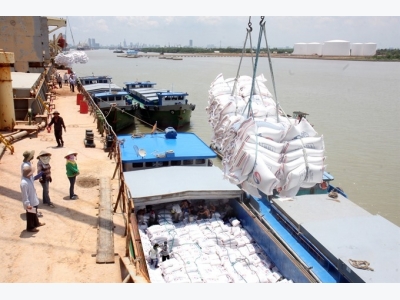Farm exporters warned on pesticides

Bags of rice are loaded onto a ship for export at Nhà Bè Port in HCM City. — VNA/VNS Photo Đình Huệ
Ho Chi Minh City — Vietnamese exporters of farm produce must learn more about food-safety requirements and maximum residue limits (MRL) of importing countries, experts said at a workshop held in HCM City on Thursday.
Farm produce exports have greatly contributed to total export revenue, with exports reaching an average growth rate of 2.4 per cent per year in the past five years, according to Chu Văn Chuông, deputy head of the Ministry of Agriculture and Rural Development’s Department of International Co-operation.
In the first 10 months of the year, the country earned US$15.62 billion from exports of farm produce, a year-on-year increase of 15.2 per cent.
Exports of fruits and vegetables, cashew nuts and rubber increased strongly, but many farm products were returned since they did not meet MRL requirements set by importing countries, according to the Plant Protection Department.
Vasant L. Patil of Crop Life Asia explained that MRL stood for maximum concentration of pesticide residue (expressed as mg/kg) likely to occur in food commodities and animal feed, MRLs are not toxicological threshold values, but they are applied as trade standards and compulsory compliance duties.
When an agricultural product has exceeded the amount of residue, for example, it cannot be accepted for trade but can still be safe for human health.
Trần Thanh Tùng, general director of the Southern Pesticide Control and Testing Centre, said importing countries had often changed food safety regulations on farm produce.
Since there are many MRL systems around the world, compliance can be difficult as some exports can meet MRL standards of one importing country but may not be accepted by another country.
Understanding differences in MRLs is key to ensuring speed-to-market for food manufacturers, traders and retailers, he said.
There are many factors leading to pesticide residue in agricultural products, including physical and chemical properties of pesticides (stability in the environment); improper use of pesticides (such as overuse and improper pre-harvest intervals), and problems in preservation.
To reduce the risk of pesticide residue in agricultural products, producers and exporters should understand the MRL requirements of importing countries, be aware of the list of pesticides used in importing countries, and pay attention to prohibited pesticides, experts aid.
Enforcement
Việt Nam has regulations on MRLs standards, but enforcement has encountered problems.
Meeting such standards requires the participation and accountability of all stakeholders involved in the value chain, including State management agencies, farmers, pesticide producers, and processing companies, participants at the conference said.
As the MRL standard is not uniform across countries, they suggested that countries in the region should work together to develop a common data package, mutual recognition of residue data, and common adoption of MRLs.
Kohei Sakata, chairman of Crop Life Vietnam, said the conference’s objective was to give stakeholders a chance to discuss challenges and solutions to increasing the volume of agricultural exports.
Organised by Crop Life Việt Nam and the Plant Protection Department, the workshop on enhancement of export capabilities of Việt Nam agri-products included group discussions and solutions on promoting fruits, vegetables, rice, tea and pepper.
Có thể bạn quan tâm
 Vietnam exports over 5 million tonnes of rice in ten months
Vietnam exports over 5 million tonnes of rice in ten months Vietnam shipped 5.05 tonnes of rice worth 2.25 billion USD in the first ten months of 2017, up 22.3 percent in volume and 21.1 percent in value year on year
 Vegetable, fruit, flower should be listed national key products
Vegetable, fruit, flower should be listed national key products Meantime, vegetable, fruit and flower was up 30 percent a year on average. The sector's export turnover is forecast to reach US$9-10 billion by 2022
 Cashew nut exports expected to exceed US$3 billion
Cashew nut exports expected to exceed US$3 billion Việt Nam’s cashew nut exports are forecast to surpass the US$3 billion benchmark for the first time in 2017 thanks to increasing shipments